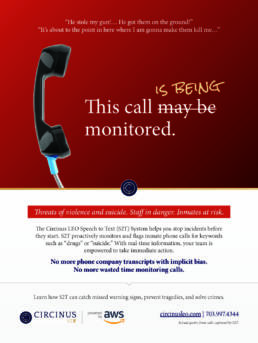
Why Print is Still Critical to Your Communications and Marketing

Breck is the winner of a Gold 2018 MarCom award for Print Advertising! The ad appeared in the September/October edition of Sheriff & Deputy magazine. This recognition underscores an important fact that sometimes gets ignored in today’s online world: Print, whether in the form of ads, brochures, or other collateral, still matters when it comes to marketing brands today.
Road Signs
Paradoxically, printed materials can guide your prospective clients to your website and your digital presence. For example, attendees at events and conferences may not immediately visit your website on their mobile phones, and if they do, they may forget to check it again later. However, they may look at your postcard or brochure in a quiet moment in a hotel room or plane, then look you up on social media or visit your company site.
Standing Out
Your website may be creative and well designed. However, social media pages do tend to blend together. Physically printed materials allow for a tangible, creative ways to differentiate your brand. Color, shape, size, texture, fold—there are multiple ways for a brochure to stand out beyond the usual size and shape.. At events, printed materials can serve as the first exposure to your brand—and be dynamic and attention-grabbing, as well as a reminder to follow up with you later.
Print May Be Down—But More Engaged
Print circulations are down; stories about newspapers or magazines folding or letting go of journalists are common. However, that means that remaining readers may be more engaged with the publication, especially with professional publications for niche audiences, and more receptive to advertising. Print has evolved into publications for every category and for very specific market niches. Magazine readers often spend money to subscribe for this content, meaning the ads in most magazines are relevant to the content that surrounds them. No clickbait, and no annoying pop-ups.
The quality of engagement is important as well. Think about the last time you had time to look at a real magazine or newspaper while traveling or in a waiting room. Did you go more slowly to use up the time? Did an ad catch your attention in a different way because you came across it at a more leisurely pace? Readers give undivided attention to magazine and newspaper content when they have the time to pick it up, as opposed to the multitasking we do when we consume digital content. Consumers gain a closer connection with print marketing because they must engage with it on a physical level, much more so than scrolling past a banner on a website.
Print Is at the Top of the Funnel
“Print is still a top-of-funnel medium,” Andy Blau, senior vice president of finance and advertising at Time Inc., notes on the American Marketing Association blog. Digital marketing and advertising provide a direct response based on keywords and targeted advertising. But print can communicate more broadly and establish your brand identity to a broader audience. Print has a longer shelf life, creating more opportunities for readers—and potential customers—to tangibly interact with an ad or a brochure.
Print is a vital component of your overall marketing plan. With graphic design, messaging, copywriting, and targeted buying, print in the right hands can boost your brand identity to audiences who matter.

